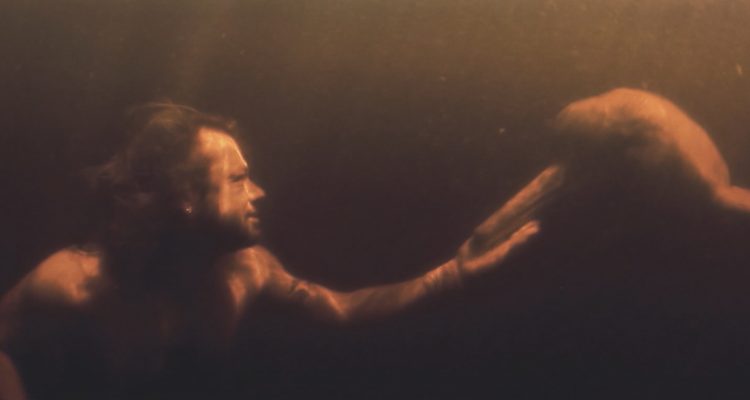In the first 15 minutes of the documentary “A River Below,” director Mark Grieco introduces two unforgettable characters and one mystery. First up is Fernando Trujillo, a conservationist who’s spent years leading a team that tracks the population of Amazon river dolphins—a.k.a. “pink dolphins” or “botos”—in order to warn Brazilians that careless native fisherman are endangering one of their country’s most beloved native animals. Trujillo is one of many conscientious scientists who work behind the scenes to collect data, file reports, and safeguard the world’s natural resources. Grieco immediately contrasts him with Richard Rasmussen, a burly, charismatic TV host whose programs on Brazil’s National Geographic channel have drawn attention to environmental crises and the plight of the local wildlife, mainly by dropping this man into the thick of the rainforest, to grapple with nature Bear Grylls style.
For all of Trujillo’s scholarly efforts and Rasmussen’s boisterous advocacy on the botos’ behalf, the event that most galvanized the public and the government to act was a stomach-turning video that aired on one of Brazil’s most popular television programs. Shot in the dark of night, the footage shows fishermen harpooning then slaughtering a pregnant dolphin, so that they can use the carcasses as bait to catch the scavenger fish pirapitinga—a cheap source of meat often processed and sold throughout the region under different names. The gory clip so horrified viewers that Brazil instituted a ban on catching and selling bottom-feeders.
And herein lies the mystery: Who filmed this massacre? And why? The hubbub over the video’s contents was so deafening that it was hard to hear anyone questioning its origins.
READ MORE: 2017 Tribeca Film Festival Preview: 20 Must-See Films To Watch
“A River Below” starts out as the story of one kind of scandal and then becomes about another—one which at the moment isn’t widely known. (After the movie begins screening, the story might blow up, at least in Brazil.) According to what Grieco uncovered, activist groups planned and executed the exposé, with Rasmussen using his connections both to facilitate the hunt and to film it. Everyone’s intentions were noble. But this documentary pushes back against the deed and its aftermath, asking if the ends justified the means.
About halfway through “A River Below,” Grieco arrives in a small village with his crew, where he finds the fisherman who killed the pregnant boto—all of whom immediately pull out their phones and start filming Grieco, so that they’ll have their own record of the encounter. This is where the filmmakers’ journey begins, in an eerie moment where they realized the video had harmed more than just one dolphin. If there’s one big knock against “A River Below,” it’s that the film itself probably should’ve started here too, and acknowledged more that Grieco had to become a character in his own investigation to see it through.
Instead, the director really only asserts himself in his interviews with Rasmussen, which start out congenial and become increasingly contentious as he asks the TV star to defend his choices, and to speak to the communities of Amazonian natives he possibly exploited. The fishermen contend the video was something they were paid to do, and that the resultant backlash has depressed their income and turned them into pariahs among their people. They say they’ve received death threats, for participating in a staged hunt. Rasmussen and other conservationists counter that they didn’t do anything unethical or illegal, and didn’t film anything that wouldn’t have happened anyway.
Grieco’s day job is as a photojournalist, and he brings that experience into “A River Below,” always looking for a shot that’s both true to reality and—if possible—striking to look at. He sometimes fumbles a bit as a storyteller, letting his journalism side down with a jumbled chronology and some confusing narrative gaps. (Also, the title is way too vague for a documentary that’s generally so accessible and gripping.) But even someone who watched this movie with the sound turned off would walk away remembering its haunting underwater shots of pink dolphins swimming in golden-hued river-water, as well as the way Rasmussen commands the attention of any nearby camera with his steely intensity.
But don’t mute “A River Below,” because the conversations Grieco has with Trujillo and Rasmussen and others encompass more than just endangered animals—although even if that was all the movie had in mind, it’d be worthwhile. The almost preternaturally telegenic qualities of Rasmussen, as opposed to the quiet academic authority of Trujillo, speaks volumes about how the public responds to important information. The reason why “fake news” works (the real kind at least, not the accurate reporting that powerful people consider unfairly slanted) has everything to do with packaging.
At one point in “A River Below,” Trujillo tells Grieco about an incident where he went on TV to warn against the rising levels of mercury in scavenger fish sold in Colombia, and as a result had to start wearing a bulletproof vest, to protect himself from fisherman economically disadvantaged by his findings. Rasmussen, meanwhile, even finds a way to charm the villagers who previously claimed to want to kill him for the way he screwed them over. There’s a lot of meaningful debate in this movie about whether it’s okay to manufacture data to support a deeper truth. But in the contrast between two very different wildlife-protectors, Grieco makes another valuable point: It takes a special breed to be a sacrificial dolphin. [B+]
Follow along with all our coverage of the 2017 Tribeca Film Festival.

